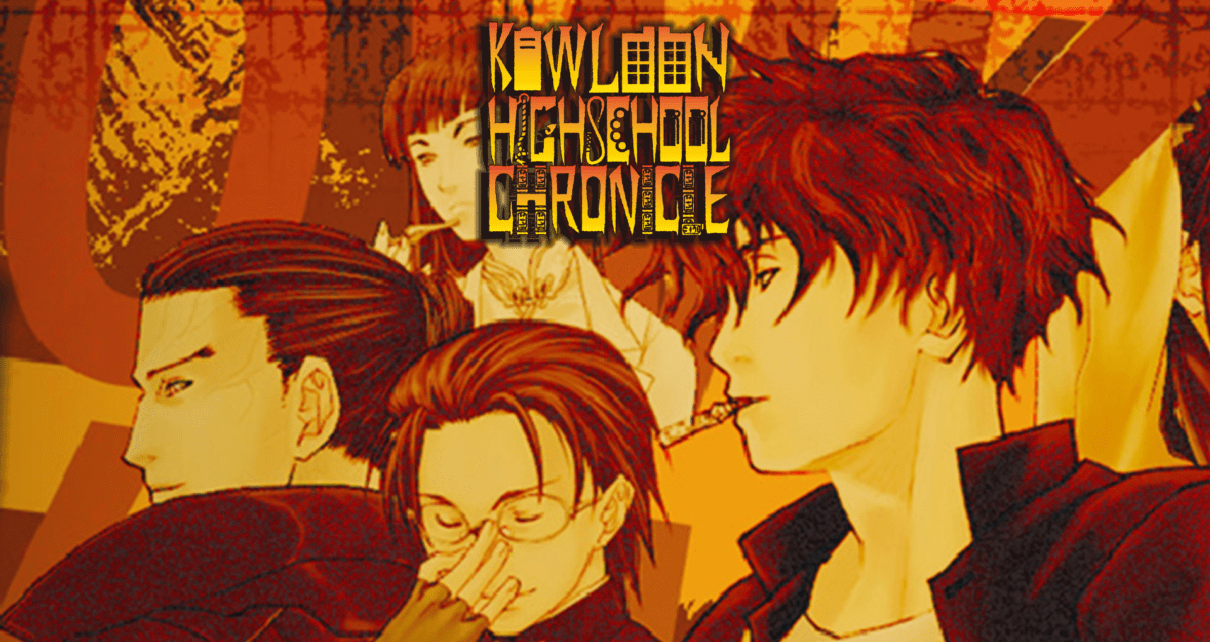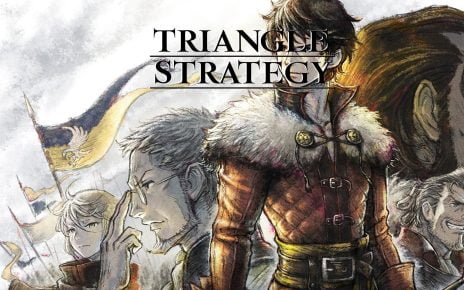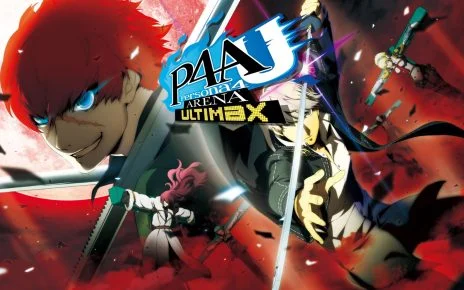Are you a fan of school-based visual novels? What about anime? Classic first-person dungeon crawlers? Indiana Jones? What if I told you there was a game that took all of those things, grabbed a steamroller made from an infinite number of smaller steamrollers, and mashed them together into one game? I suspect you would brandish your freshly whitened glove and slap me across the chops for even suggesting such nonsense. That game exists though – and it’s called: Kowloon High-School Chronicle.

A Late Western Release
Kowloon High-School Chronicle has been around for quite some time – 17 years in fact. The game was a Japanese title that never left their shores until now and went by Kowloon Youma Gakuen Ki. Calling its western release unusual is an understatement. We simply don’t get games this old, and this niche. Alas, here we are. But was it worth the wait? Maybe.
The game opens up in what looks like an Egyptian pyramid and you are tasked by an old guy to find an ancient relic. You go through a tutorial dungeon, get captured by an international relic-hunting crime conglomerate, escape, and then get sent to a high school as an undercover treasure hunter posing as a regular student. It makes sense within the context of the world, I guess, but things get even stranger as time goes by.
The school is filled with…interesting characters, most of which will want to be your best bud. Some of them look like they have a couple of seconds to live. Others are so perky that the sun itself feels less incandescent. Heck, one guy likes to lick rocks. Eventually, you realize the school itself is not as it seems. The teachers are basically slaves to the Student Council. The Student Council are more than a little bit murderous and the school has a graveyard that houses an easily accessible labyrinth of ancient Egyptian-style tombs filled with monsters. But that’s not all. The shopkeeper is probably a pedophile and immediately commits a handful of sex crimes when you first meet him.
The game’s tone is all over the place. One moment you are a cheesy treasure hunter, the next some dozy tart is blowing people up with her mind. Later on, there’s some slapstick noncery going on, followed by front-flipping gimps. You really can’t make this up. It’s truly unique in the best way possible. It simultaneously wants to tell a serious story, but then you find the shopkeeper jacking it to some students in the shower, or some aliens start abducting people or something.
This might seem overwhelming, and that’s because it is. Once you complete the tutorial, there is no gameplay for roughly 2 hours. It’s all exposition and dialogue between characters. This dialogue is interesting in places, but this is a Japanese title. The characters take far too long to say incredibly simple things far too often. By the time they finally shut up, I was almost ready to pack my bags and call this one a loss. Don’t do this, because the game picks up immediately after this.

Exposition before Adventure
Kowloon is split into two distinct parts – the setup to an adventure, and the adventure itself. As you can probably guess, this tirade of gobbledygook crashing against your meat-computer is the setup. The dungeoneering experienced much earlier in the game is the adventure itself. The game literally plays like an anime. Every chapter plays out like this: Opening cliffhanger/hook, into anime opening sequence, into exposition, into adventure, into resolution, into anime credit sequence. Each chapter will take you a few hours to get through, and honestly, once it gets going, is really addictive.
The game’s format is ideal for the Switch in particular. I was able to sit down, go through a self-contained story about a pale-gimpy-dude stealing peoples hand-energy because music is bad or something, and walk away content. The next day, I was compelled to go back and play another, and then another. The excessive amount of exposition and repetition is less noticeable because it was split into easier to digest chunks.
But how does the game actually play? It’s a mixed bag. Conversations are mostly just pressing to continue. Every now and then you will get the option to emote in some vague way. A wheel appears on the screen covered in badly written, difficult to decipher words and you just pick which word best describes how you want to act. This worked fine some of the time, and others I accidentally thought that murder was a fantastic idea. There are more traditional choices to be made, but these don’t massively change how things play out. You might get some dialogue you would otherwise miss. It’s not a big deal.
During the intermissions, you are met with a map screen. You can move your cursor around various faculty buildings, talk to people and loot the odd pen or eraser. It breaks up the dialogue with more dialogue and the opportunity to save. It’s a time-waster for the most part, but it lets you interact with minor characters such as the rock-licking geezer from before.

Into the Dungeon
Dungeoneering is where it’s at. These segments are entirely first-person and you move on a grid. You control like a clunky tank, but this is common for the genre. Each dungeon is riddled with various puzzles and traps that you need to bypass to advance. Between you and advancement, however, are the occasion mob of enemies. Kowloon’s combat is an interesting mix of real-time and turn-based. Each turn you are allocated several Action Points (AP) and can spend them to move around, perform actions, and attack. Once you’re out of points, your turn ends and all the enemies take their turn shambling towards you and attacking if possible.
Each enemy has a weakness, whether that be a specific weak point or an aversion to certain damage types. A mummy might be resistant to being slashed at with a knife, but weak to a blackboard eraser you found in classroom 3C earlier that day. Push comes to shove, throw a grenade, it’ll probably work. Melee is the simplest way to interact, and probably the least efficient against the majority of enemies. Ranged combat is the way to go, and due to how the Action Point system works, you can easily kite enemies until they die. Shooting enemies with a gun allows you to exploit weak points, and these vary from enemy to enemy. It might take 30 shots to kill a hovering, slowly rotating, water-carrying…thing, but that same guy will die to 2-3 shots to his water-pot…for some reason.
It’s all about experimentation and learning what tools work against what enemy. It’s very engaging and kept me hooked throughout each expedition. You aren’t alone when exploring either, although you kind of are. You can take two NPC buddies with you when you go delving, and whilst they can’t attack, take damage or really do anything, they come with unique passive skills that make combat a tad easier, and a unique active skill that might assist in killing an enemy, or keeping you alive. Finally, they grant bonuses to your core stats, potentially doubling your effectiveness in certain categories when they tag along. You unlock more buddies as you go, and choosing who to bring is a legitimately difficult decision and can radically change your character build.
Speaking of builds and stats, your character levels up over time and you are given the daunting task of allocating various skill points. Some can increase core attributes, making you stronger, tougher, or more proficient with guns. Whilst others increase your proficiency in specific areas of the game. These are named after school classes and can drastically change how you explore each dungeon. Pumping up your mathematics allows you to open more complex locks whilst being better at Japanese will increase quest rewards. There are a bunch and deciding what to increase, and when, could change how you complete certain tasks.
Outside of combat, actually navigating each dungeon is quite enjoyable. There is a lot of verticality to each dungeon allowing you to use grappling hooks to explore areas that may seem completely inaccessible. You can also jump a staggeringly far distance (further if you invest in Physical Education) which might unlock alternate routes or hidden treasures. Puzzles don’t just require you to find X and put it into Y, they sometimes expect you to take items from outside the dungeon, combine them, and use them in specific circumstances. For example, mixing various acids to create a concoction strong enough to melt gold chains sealing a door shut. It’s good stuff that engages the bonce in a number of interesting ways.

Issues and Quirks
Not everything is fine though, and Kowloon struggles in many areas that, honestly, hold it back to the point where some people might just give up. The game is old and has not been modernized in several important areas. The menus are clunky and interacting with everything is slow. The quest system might as well not exist because it’s not explained, composed entirely of riddles, and a mess. I found myself just being frustrated in the early game with no idea what the game wanted me to do, and the interface just got in the way. Even as I approached the climax, it never felt great even though what I was doing was fun.
Another quirk the game has is its night-time dormitory menu. This small window contains a number of incredibly useful things. For example, the shop. As a Brit, I was more than a little shocked at how easy it was to purchase explosives and high-caliber assault weaponry and have it delivered to my doorstep. There are weapons in the dungeons, but this is probably where you will go to pick up side-arms and ammunition throughout the experience.
The strangest thing in Kowloon High-School Chronicle is the “Game” option. I assumed this would take me to some settings. I was wrong. If you select this option you are whisked away to another game entirely. This side-game is a corny crime thriller with a traditional 8-bit RPG combat system. It’s surprisingly good and well worth playing through if you want a break from the usual nonsense Kowloon has to offer. It’s a shame it’s almost hidden and not advertised more clearly.

Production Values
Then we have the less impactful, but still disappointing issue of the visuals. In many aspects, they are just bad. Unacceptably bad – even for the time, and these are the revamped versions! Conversations are fairly ugly anime cutouts standing in front of a horribly blurred image that legitimately gave me a headache after a while. In dungeons, the UI is borderline hideous and the environments aren’t as varied as I would have liked. That being said though, the enemy sprites are really impressive. These are very large and incredibly detailed with a surprising amount of animation to their movements. They look goofy as all hell though. This was a Japanese game, and I suspect the imagery was meant to be spooky. But as a westerner, I am not creeped out by sentient pottery that houses some skinny bloke in a weird hat, you know?
The music, and sound quality in general, is fine. Tracks fit whatever situation is happening on the screen, and sound effects are, at the very least, a step above the majority of the visuals. The game has a fair amount of voice acting, although it’s all in Japanese. I’m not an expert on Japanese voice acting, but most of it was pleasant on my ears. There was only one instance where I genuinely wished my character had stabbed someone, so that’s probably a good sign on the whole.

Verdict
Kowloon High-School Chronicle is a hard game to recommend. It’s old in a way that makes it unpleasant at times, but the core concept is rock solid. Once you get past that initial wall of text, you’re in the clear. That being said, there are much better dungeon crawlers out there, and Kowloon is not good enough to recommend over them. What it has in spades, however, is a theme that is quirky, endearing, outlandish and totally unique. I would wait for a sale before you pick this up, and even then, only if you really appreciate Japanese-Indiana Jones-Anime-Horror-Comedies.
WAIT FOR SALE ON KOWLOON HIGH-SCHOOL CHRONICLE

If you enjoy quirky RPGs, perhaps you’d like to take a look at Undead Darlings
Many thanks goes to Arc System Works for a Nintendo Switch review code.

Forged in the rainy wilds of northern England, I carved a path of mediocrity through generations and genres. My play style is often described as: “optimistically awful”.




